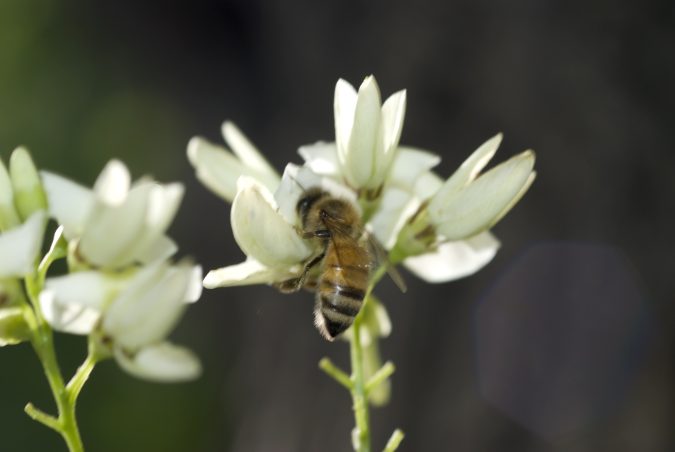| Family: | Fabaceae |
| Genus: | Styphnolobium |
| Species: | S. japonicum |
| Common names: | Chinese scholar tree, Japanese pagoda tree |
| ZBAS | 6 (0 to 10) Zach’s bee attraction score |
This plant is a large tree, endemic to China but named (both the Latin name and the common name) as “from Japan” most likely because the botanist giving the name first identified it in Japan. In fact, it is named as “National locust” (Guo huai) in China. There used to be one tree right in front of the Natural Science Building at MSU, which was cut down. But now, there is still one near the edge of the parking lot at the intersection of Psychology Road and Farm Lane, and another one near the MSU Union. This one is blooming as of today but I saw the one near the union blooming 2 weeks ago. It is not as attractive to honey bees as black locust but it is blooming time is important in Michigan for honey bees. I saw many bumble bees and carpenter bees today but the flowers are near the top of the 30-ft-tall tree and it was difficult to see if honey bees were there. The flowers have a slight greenish-tint and I could not smell them today. The tree that was cut used to drop many flowers on the ground and many bees, including some honey bees wiould work on the fallen flowers. Thus this flower also tends to “flow” near its end, similar to black locust.
The young leaves of this plant are used to make tea in China and seedpots are used in traditional medicine.
Those photos are taken August 29th 2003, from the MSU campus, using an old point and shoot camera (Nikon Coolpix 990). I swear I have other photos and even remember taking pictures of bees foraging on the fallen flowers but today I spent a good two hours and could not find them. But the good news is, I finally found my old photos of honey bees foraging on small leaf plantain!
1. A honey bee foraging on the Chinese scholar tree flowers. Flowers are white with a greenish tint. Young seed pods can be seen, suggesting a long and unsynchronized blooming time for a single tree. 
2. A honey bee foraging on the same flower but taken in China (Beijing), Aug 7, 2007. 
3. A carpenter bee also foraging on this flower. The flowers are not larger than black locust, so I am intrigued why more large bees (resin bees, carpenter bees, and bumble bees) than honey bees. 
Please complete a brief survey at the end of this page. This should only take about 2 minutes. Please click the link to a the post-blog survey, which is anonymous and collects no personal information.

